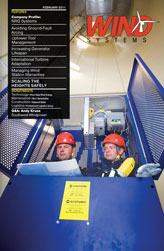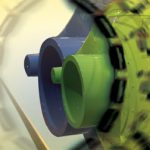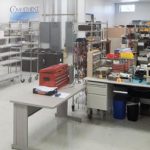When it comes to getting a job done right, having the right tools at hand can make all the difference. Whether that job is performing routine maintenance at a nearby jobsite or an emergency repair on a wind tower 250 feet in the air, technicians need to be able to get their hands on the necessary tools fast.
And it’s not just about getting tools to the jobsite, it’s about getting the right combination of tools without leaving any crucial pieces behind. Figure 1
Using mobile tool cribs that come with tool-control technology, as well as devising specialized tool kits for specific jobs, can help technicians work more effectively and productively to get the job done quickly.
Making Tools Mobile
Sometimes getting the tools to the jobsite itself is half the battle, especially if it’s located halfway across the world. A mobile tool crib can be an efficient and economical solution by allowing tools to travel from one site to another, instead of incurring the high cost of supplying both sites with the same set of tools. When managed properly the mobile tool crib is an integral component of a jobsite, especially at larger wind farms or sites in remote locations.
The idea and practice of a tool crib is nothing new, of course. What is new, however, are well organized tool cribs that offer a totally controlled environment, increasing jobsite productivity while reducing costs. Next-generation mobile tool cribs from Snap-on Industrial offer the latest technical advances including asset management software that reduces tool replacement costs while increasing jobsite efficiency.
Mobile tool cribs are also becoming more mobile. Instead of having technicians go back and forth to a tool crib, which is often in an existing facility a distance from the actual jobsite, tool cribs are now coming to the workers. Mobile tool cribs can be customized and set up directly on a jobsite. Modular in design, mobile tool cribs include storage and control systems, cabinets, and shelving, plus electrical components that include lighting, air conditioning, and electronic keyless entry systems. Some suppliers even provide trained tool crib attendants to manage the mobile tool crib on site.
Mobile tool cribs house all tools and equipment, typically in conex-type containers of 20 to 40 feet in length. To aid in tool organization, mobile tool cribs come with custom-built cabinetry and shelving, detailed with foam inserts to keep even small tools in place. All tools housed in the mobile tool crib have been specified by the customer. This allows the user to avoid paying for unneeded additional tools, and ensures that the requested tools will be integrated into the organization system before the crib arrives.
Keeping Inventory
Once the mobile tool crib is operational on the jobsite, keeping track of it allows workers to quickly access tools when needed. Traditional tool cribs are notoriously difficult to navigate, with a take-it-when-needed tool checkout policy that can lead to wasted time and lost tools. To alleviate this problem, mobile tool cribs use asset management software to help increase tool accountability.
Asset management software keeps track of the tools and also enables the tool room attendant to track usage trends, output valuable management reports, and provide a clear indication of what truly is available in inventory. When new tools are added, the tool crib attendant assigns them a bar code and updates the system to reflect an accurate count. Figure 2
Security also can be an issue at job sites. Newer tool cribs use ID cards instead of keys, so that managers know who accesses the crib and when. The same key-card is used in connection with the tool control system to identify who is checking out which tools. This way lost tools can be traced back to the worker that last accessed them, whether or not they were returned to the crib, reducing misplaced tools and costs. When the job is finished, mobile tool cribs can be loaded onto a tractor trailer for delivery to the next jobsite. The company also receives a printout of what tools need to be replaced, recalibrated, or recertified before the mobile tool crib moves on.
Custom Kitting
Nothing is more frustrating to a technician than when that one crucial tool to get a job done has been forgotten, even if it’s simply back at the tool crib. Consider the technician working 300 feet in the air on a wind turbine. It’s common for technicians to carry a bag with more than 100 tools from turbine to turbine, but what happens if he forgets a tool on one turbine after scaling another? That last thing he wants to do is scale that other turbine just to retrieve a tool. Whether the technician is up in the air or on the ground nothing wastes time, productivity, and money more than needlessly walking back and forth from the job to the turbine or tool crib to retrieve a forgotten tool. However, one way to make sure that the tools needed for specific jobs make it there is by creating a custom tool kit.
Here’s a common application for how a custom kit works. For example, a piece of machinery that undergoes routine preventive maintenance every three months would have a kit created and ready to check out from the tool crib with all the necessary tools needed to complete maintenance on that job. By kitting those tools in the crib, a technician needing to do that repair doesn’t have to check out the 10 tools individually. Rather, he simply checks out the kit, knowing he has all the tools to complete the job. Figure 3
An ideal use for a custom kit is preventive maintenance. That’s because many facilities have equipment, machinery, and systems that require regular ongoing preventive maintenance as part of their operation. A custom kit can be developed to house all the necessary tools required to perform preventive maintenance on specific components. All the technician has to do is check out the kit from the tool crib to know that he has all the necessary tools to complete the job.
Getting Started
The first step for a customer in creating a custom kit is to work with a Snap-on Industrial representative to identify the tools needed for the particular job, and in the process look for efficiencies in the way maintenance is performed. A larger customer may have up to 15 different applications requiring kits of various sizes. The key is identifying those needs and developing kitting solutions that improve efficiencies and ultimately save time and money. Figure 4
Just as organization and accountability are important aspects of the mobile tool crib, these attributes are also sought after in custom tool kits. All kits come with cutout foam placements for tools, which provide a higher level of organization and accountability. This added level of organization offers inventory control for safety and theft prevention advantages and ensures the technician can account for every tool in the kit at a glance.
The days of lost tools are quickly becoming a thing of the past. Every day mobile tool cribs and custom kits are saving technicians time and money. As companies look to continually improve efficiencies, today’s tooling solutions offer the combination of good asset management processes and high tool security. It’s a winning combination.








































